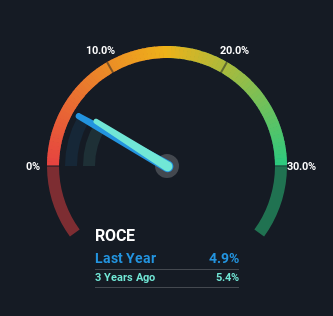- United States
- /
- Electric Utilities
- /
- NasdaqGS:EVRG
Return Trends At Evergy (NASDAQ:EVRG) Aren't Appealing
Did you know there are some financial metrics that can provide clues of a potential multi-bagger? Firstly, we'd want to identify a growing return on capital employed (ROCE) and then alongside that, an ever-increasing base of capital employed. If you see this, it typically means it's a company with a great business model and plenty of profitable reinvestment opportunities. Having said that, from a first glance at Evergy (NASDAQ:EVRG) we aren't jumping out of our chairs at how returns are trending, but let's have a deeper look.
Return On Capital Employed (ROCE): What Is It?
If you haven't worked with ROCE before, it measures the 'return' (pre-tax profit) a company generates from capital employed in its business. The formula for this calculation on Evergy is:
Return on Capital Employed = Earnings Before Interest and Tax (EBIT) ÷ (Total Assets - Current Liabilities)
0.049 = US$1.4b ÷ (US$32b - US$3.6b) (Based on the trailing twelve months to September 2024).
Therefore, Evergy has an ROCE of 4.9%. On its own that's a low return on capital but it's in line with the industry's average returns of 4.8%.
See our latest analysis for Evergy

In the above chart we have measured Evergy's prior ROCE against its prior performance, but the future is arguably more important. If you're interested, you can view the analysts predictions in our free analyst report for Evergy .
What Does the ROCE Trend For Evergy Tell Us?
There hasn't been much to report for Evergy's returns and its level of capital employed because both metrics have been steady for the past five years. It's not uncommon to see this when looking at a mature and stable business that isn't re-investing its earnings because it has likely passed that phase of the business cycle. So unless we see a substantial change at Evergy in terms of ROCE and additional investments being made, we wouldn't hold our breath on it being a multi-bagger. That probably explains why Evergy has been paying out 66% of its earnings as dividends to shareholders. Most shareholders probably know this and own the stock for its dividend.
Our Take On Evergy's ROCE
We can conclude that in regards to Evergy's returns on capital employed and the trends, there isn't much change to report on. Unsurprisingly, the stock has only gained 7.3% over the last five years, which potentially indicates that investors are accounting for this going forward. As a result, if you're hunting for a multi-bagger, we think you'd have more luck elsewhere.
On a final note, we found 3 warning signs for Evergy (1 is a bit unpleasant) you should be aware of.
For those who like to invest in solid companies, check out this free list of companies with solid balance sheets and high returns on equity.
Valuation is complex, but we're here to simplify it.
Discover if Evergy might be undervalued or overvalued with our detailed analysis, featuring fair value estimates, potential risks, dividends, insider trades, and its financial condition.
Access Free AnalysisHave feedback on this article? Concerned about the content? Get in touch with us directly. Alternatively, email editorial-team (at) simplywallst.com.
This article by Simply Wall St is general in nature. We provide commentary based on historical data and analyst forecasts only using an unbiased methodology and our articles are not intended to be financial advice. It does not constitute a recommendation to buy or sell any stock, and does not take account of your objectives, or your financial situation. We aim to bring you long-term focused analysis driven by fundamental data. Note that our analysis may not factor in the latest price-sensitive company announcements or qualitative material. Simply Wall St has no position in any stocks mentioned.
About NasdaqGS:EVRG
Evergy
Engages in the generation, transmission, distribution, and sale of electricity in the United States.
Average dividend payer with questionable track record.
Similar Companies
Market Insights
Community Narratives



